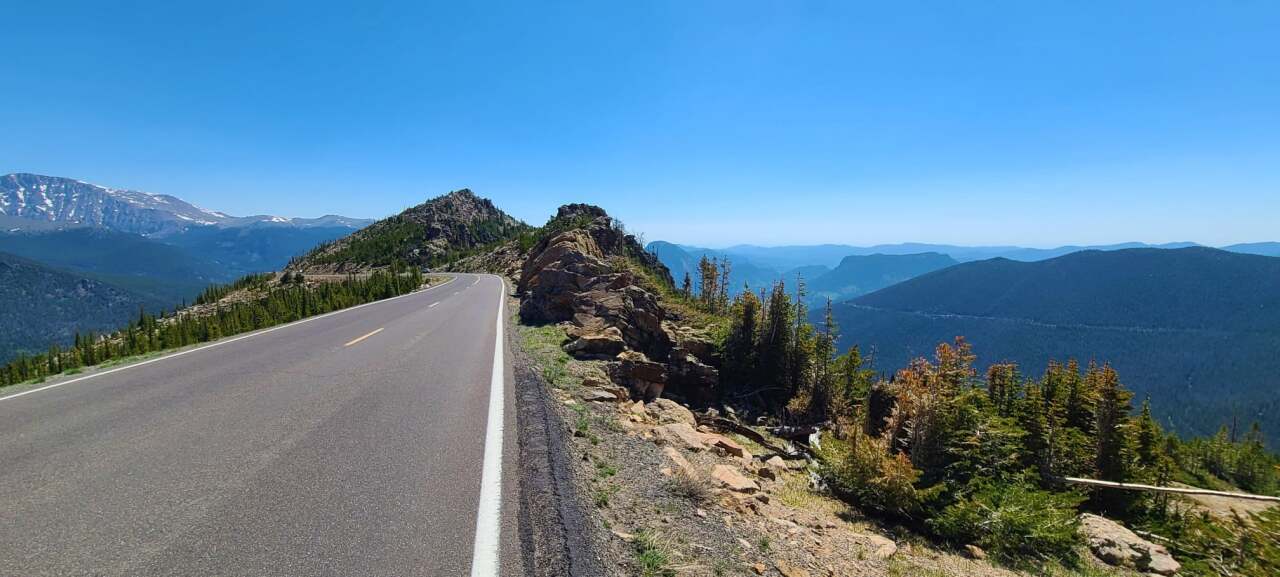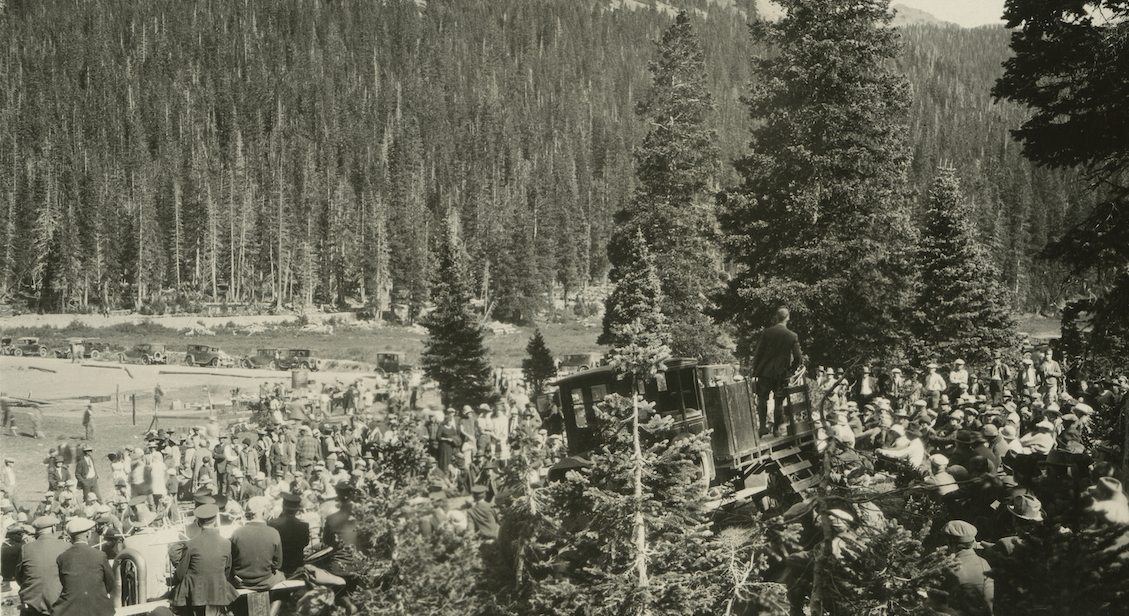ESTES PARK, Colo. — Trail Ridge Road is an impressive feat of engineering and Colorado history, soaring more than 12,000 feet in elevation through Rocky Mountain National Park.
Good luck choosing the best adjective to describe the views, but on the occasion of the 109th birthday of Rocky Mountain National Park, we’ll give it our best try.
“When you go up there, you actually feel like you’re on top of the world,” said Tami Roberts, a popular photographer in Denver7’s Facebook photography group. “You always hear those cliches about nature therapy, inner peace, quiet beauty. You always hear people describe it like that, but it's actually true. That's what I feel when I'm up there.”
Trail Ridge Road, the highest continuous paved road in the United States, is an epic Colorado experience and nearly 100 years old.

Digital Originals
Rocky Mountain National Park turns 109: A timeline of notable events and figures
“And it is an unbelievable road,” said Kyle Patterson, spokesperson and longtime fixture at Rocky Mountain National Park. “When you get to the top of Rocky, which the highest point is 12,183 feet, throughout that road, you experience all the different life zones of Rocky.”
Through Trail Ridge Road’s 48 miles, visitors find themselves in awe of the changing vegetation, plants and incredible wildlife.
Roberts has seen it all through her lens.
"And I'm going down the road and I look to the side and there's a small herd of bull elk walking next to me,” Roberts beamed. “And it's like, I can't believe it's happening.”
She has spent countless hours photographing picture-perfect sunsets, sunrises and endless starry skies.
“I hate to keep using the same adjectives but it's just mind-blowing. I mean it's just the colors,” Roberts said. “That's what gets me about it. I'm always looking for those bright colors. And I just love seeing all the layers of the mountains.”

It’s a marvel Patterson has experienced through the eyes of so many visitors to Rocky Mountain National Park.
“It's something that they take away with them the rest of their lives,” Patterson said, smiling. “You see the Continental Divide, you see the Mummy Range, you see Longs Peak, which is off of the Continental Divide. It's an amazing experience for all of your senses.”
The road has delivered majestic views to visitors from around the world since it first opened in the early 1930s.

“So really, Trail Ridge Road starts before it actually exists,” said Rachael Storm, PhD. who is curator of business and industry at History Colorado. “In 1909, a naturalist named Enos Mills said, ‘Hey, we should have a national park in Colorado,’ and this is the genesis of our National Park System. And he really starts fighting to create a national park at Rocky Mountain.”
It took a while, but Mills’ hard work paid off for generations to come when in 1915, President Woodrow Wilson signed the act creating the park. Mills became known as the Father of Rocky Mountain National Park.
And in those early days, Coloradans were in a hurry to find a way to explore Rocky Mountain National Park before it became what it is today.
“Coloradans — we are an impatient bunch, and we weren't going to wait,” Storm laughed. “So, they actually started building a road up to Rocky Mountain National Park before 1915.”
That early, winding dirt path was Fall River Road.

“And it's this hairpin road that goes in really steep angles up to the top of the summit of what we consider where the Continental Divide crossover is,” Storm said.
In 1919, Congress passed funding that would eventually help create Trail Ridge Road but well before construction would even start on the road we know today, Fall River Road was completed for those early explorers.
It was an important milestone for Rocky Mountain National Park because unlike Yosemite and Yellowstone, which preceded Colorado’s park, there was no train service here.
“So it really was the first automobile National Park. You had to have something that had four wheels and drove over the road to get there,” Storm said. “People are just starting to get automobiles — they hop in their cars. Denver even offers a bus tour service up Fall River Road, which they started building in 1912. And people start driving up it before it's done."

While funding was passed for only four miles of Trail Ridge Road in 1919, it would be nearly a decade before construction ramped up.
Building Trail Ridge Road in the late 1920s was quite the process. Construction crews, who battled the tough terrain and grueling weather, could only work on the road for four months of the year.
Using tractors, horses and a gas-powered steam shovel, they worked to counter the deficiencies of Fall River Road, according to the National Park Service (NPS). At its peak, 150 people were working on the road at one time.
And then, finally, on July 15, 1932, it officially opened to Fall River Pass.

“The first year, a quarter of a million people visit the park,” Storm said. “And that's by car and bus, not by train. That's a lot of people.”
But the road didn’t quite resemble the one we know today. It was all dirt. No barriers lined the edges.
By 1934 however, funding from the New Deal brought upgrades.
“And what they do is they put in those really cool crenelated barriers that we still have up there today, where it's all hand masonry, stonework,” Storm said. “And the wall has this, you know, crenelated look to it. Where it kind of goes up and down along the side is where we often see marmot sitting these days when we drive up Trail Ridge Road.”

Despite few leisure trips, as this was the time of the Great Depression, half a million came through the park within three years of the road opening.
In 1938, the construction was completed to Grand Lake, officially connecting that community to Estes Park on the eastern side.
After Trail Ridge Road became a state highway, crews added thin poles along the road. Their purpose? To help guide snowplow drivers in the winter.

Digital Originals
The massive effort behind snowplowing RMNP's Trail Ridge Road each spring
It’s a daunting task. Snowplow drivers work from both the east and west side of the park to clear the entire road. This takes about 40 days each year.
This came to a halt during World War II, when the Department of Interior stopped snowplowing altogether and visitors were forced to wait for the road to naturally clear of snow.
Things got back on track after WWII, visitors flocked back to the beloved park. More improvements came in the 1950s, including a median line among other safety upgrades.
“You also see the introduction of modern toilets, additional road improvement on Trail Ridge Road,” Storm said.
Then came an addition on a much bigger scale: The Alpine Visitor Center.
And so the crowds continued to flood into the park, now able to explore the alpine in a brand new way.
But respect for that sensitive ecosystem, as well as the rest of the park, was lacking. Visitors were trying to feed the wildlife, car clubs held events in the park, and newspapers reported trash all over the park.

“So people aren't even trying to keep the park clean,” Storm said. “They're just throwing stuff everywhere.”
Luckily, by the late 1970s, opinions and behaviors changed for the better. By the early 1980s, $2 million helped resurface Trail Ridge Road. Since then, stonemasons have also added walls along the road and $10 million in repairs were completed.
“We've worked on drainage issues, we've worked on freeze thaw impacts that we have there,” Patterson said. “And so not only were engineers dealing with that in the 1920s, but National Park Service staff continue to make sure that we're taking good care of that historic road. It's quite amazing.”
Trail Ridge Road was designated as an All-American Road in 1996, meaning it is both nationally significant and has one-of-a-king features. It is also one of 13 National Scenic Byways in Colorado.
Today, loaded with history every mile, it remains one of the top attractions at the park.
"And I love that little stretch there where there's nothing on both sides," added Roberts. "For some reason, it just calls to me so much."






